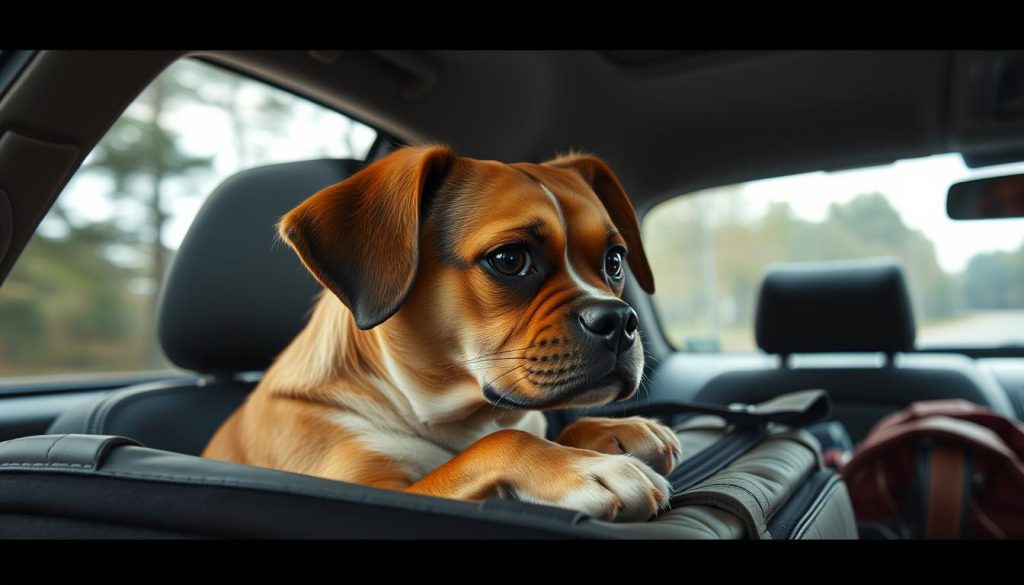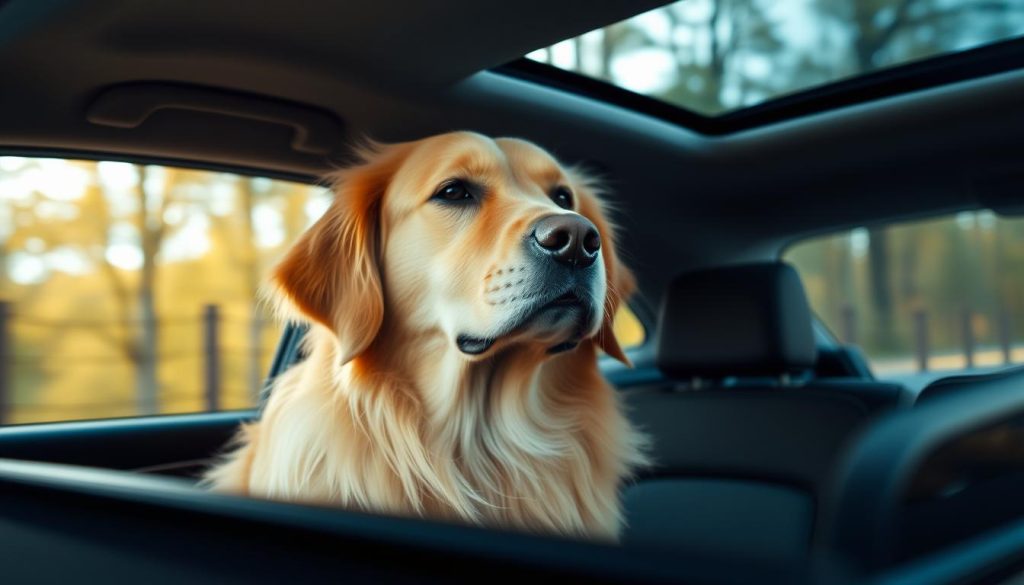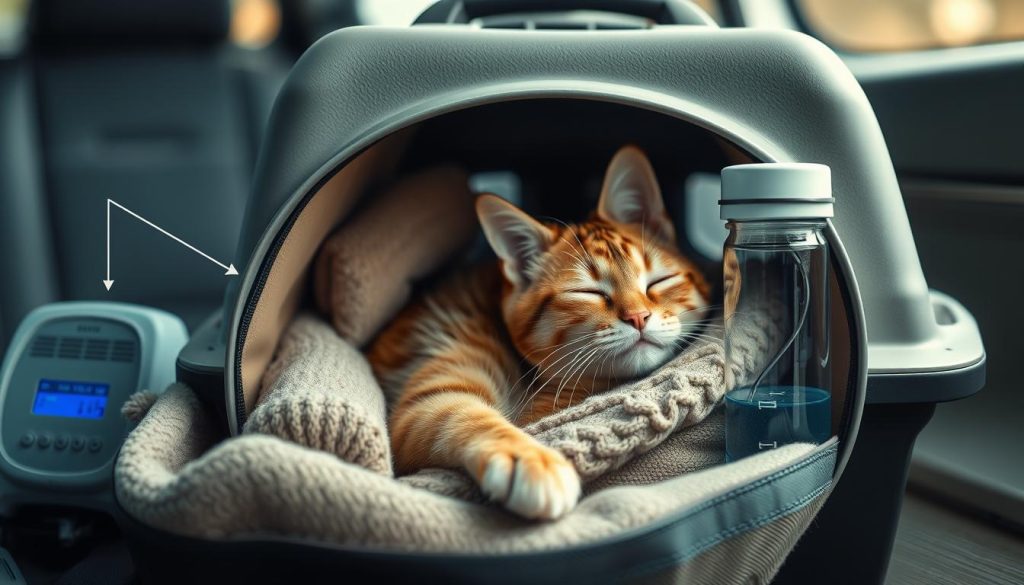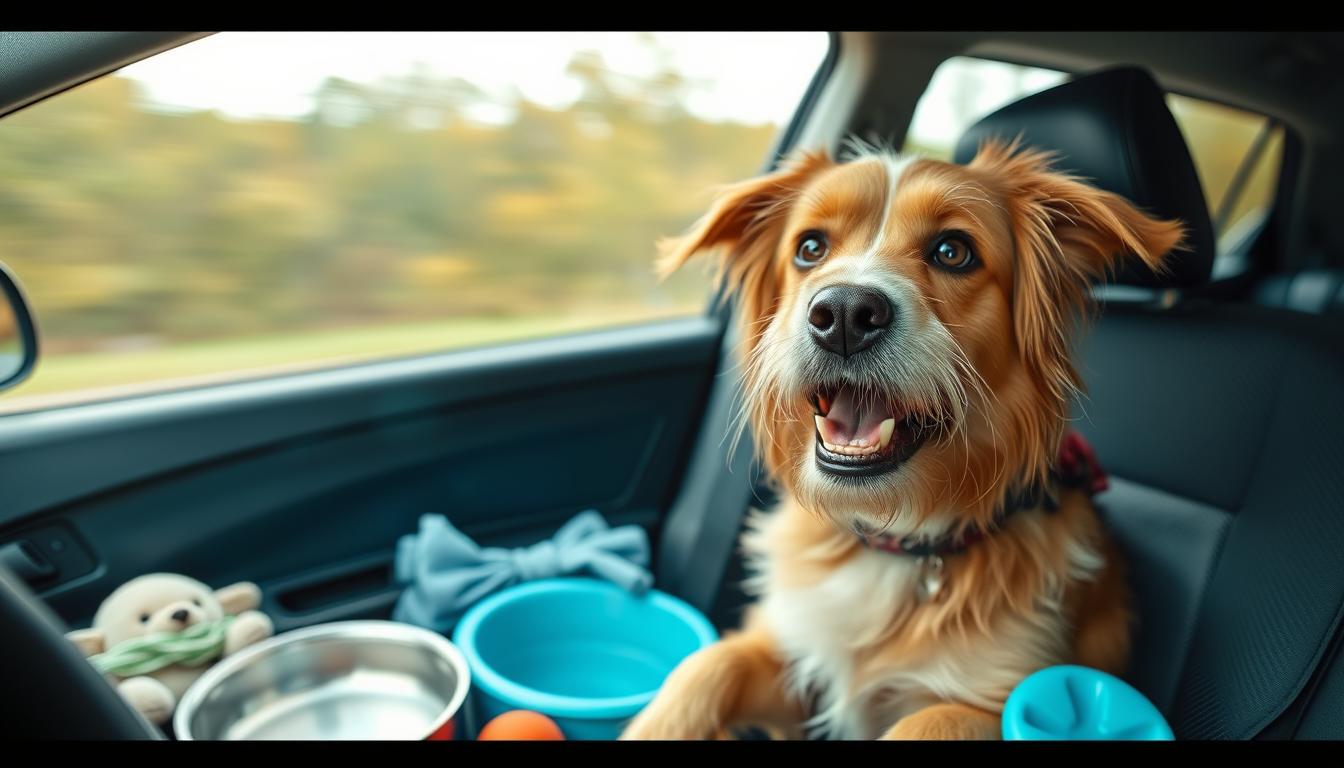Traveling with our pets can be fun, but it can also make them stressed. As a pet parent, making sure my furry friend feels safe and comfy is key. In this article, I’ll share tips to calm your pet during travel. We’ll look at how to make car, plane, or other trips easier for them.
We’ll talk about what makes your pet anxious and how to get them used to traveling. By the end, you’ll know how to make your next trip smooth for you and your pet. Whether it’s a long road trip or a weekend away, these tips will help you both relax.
Understand Your Pet’s Travel Anxiety

We all want our pets to enjoy traveling as much as we do. But, many pets feel causes of pet travel anxiety during trips. This can cause motion sickness in dogs and make them dislike car rides. Knowing why your pet feels anxious is key to helping them.
Car Sickness in Pets
Car sickness is a big reason for pet anxiety. Dogs may get sick and stressed from the car’s motion. This can lead to vomiting, drooling, and feeling bad. It makes them not want to go for rides in the future.
Classical Conditioning and Negative Associations
Pets can also link car rides with bad experiences, like going to the vet or being left alone. This is called classical conditioning. It makes them anxious and stressed when it’s time to go out.
To help your pet, you need to recognize the signs of stress in pets. Look for signs like panting, trembling, whining, or trying to get away. Knowing these signs helps you calm your pet and make trips better for you both.
Desensitize and Countercondition Your Pet

If your pet shows signs of travel anxiety, try desensitization and counterconditioning. Desensitization means slowly getting your pet used to the car. Counterconditioning makes travel positive for them.
Desensitizing a Puppy to Enjoy Riding in the Car
Desensitizing a puppy to car rides needs patience and positive rewards. Start by letting your puppy sit in the car with the engine off. Give them treats and praise.
Then, increase the time they spend in the car. Next, start the engine and take short drives. This makes the car a happy place for them.
Counterconditioning Your Anxious Pet to Feel Better About Travel
For anxious pets, counterconditioning works well. It makes the car a positive place through positive reinforcement training for travel. Feed your pet treats or play near the car at first.
Then, move these positive moments into the car. Over time, your pet will see the car as a good thing. This helps fight their fear.
Remember, desensitizing pets to car rides and using counterconditioning techniques for anxious pets takes time. But, it’s worth it. With these methods, your pet can enjoy traveling with you.
Calming Pets During Travel: Essential Tips

Traveling with pets can be stressful. But, there are many ways to keep your pets calm and comfy. Use these tips to make your pet’s travel better.
Use familiar scents to calm your pets. Bring their favorite blanket, toy, or a piece of your clothing. These smells make them feel safe and relaxed.
Anti-anxiety jackets are great for pets. They are also called calming wraps or thunder shirts. These jackets apply gentle pressure, which calms your pet and reduces anxiety.
Think about giving your pet calming supplements. Options include pheromone-based products or natural remedies like chamomile or melatonin. Always talk to your vet before trying new supplements to make sure they’re safe.
With these tips, you can make travel better for your pet. It helps reduce their stress and makes the trip more comfortable for both of you.
Prepare for a Road Trip with Your Pet
Planning a road trip with your pet? The right vehicle and gear are key for a comfy, stress-free trip. Choose a car with enough space and good temperature control. This makes a safe, fun space for your pet on the road.
Choosing the Right Vehicle
Look for a car with lots of room and easy access for your pet. A big backseat or cargo area is great. Also, make sure the car has good climate control. This keeps your pet comfy in any weather.
Pet Travel Essentials
Get ready for pet travel with the right gear. You’ll need a strong harness or crate, a waterproof seat cover, and collapsible bowls. Don’t forget your pet’s favorite toys, blankets, and any needed meds or first-aid supplies.
With the right car and gear, road trips with your pet will be great. You’ll make memories to last a lifetime.
Finding Pet-Friendly Accommodations
Choosing the right pet-friendly places is key when you travel with your pet. You want a place that makes both you and your pet happy. Look for easy outdoor access, big rooms, and amenities that soothe your pet.
Start by checking online directories and review sites for pet-friendly places. Find hotels, rentals, and other places that welcome pets. Check if they have size or breed limits, extra pet fees, and pet-friendly features.
After picking a few options, call the place to talk about your pet’s needs. Think about:
- Close spots for your pet to go to the bathroom
- Rooms big enough for your pet to move around
- Big beds or cozy spots for your pet to sleep
- Features like white noise machines or calming scents
By choosing carefully, you can make sure your pet and you have a great stay.
Plan for Frequent Breaks and Decompression Time
Traveling with pets means you need to take breaks often, especially on long trips. These breaks let your pet stretch, see new things, and play. It helps them relax and keep their energy in check.
Rest stops are key for pets on the road. They meet your pet’s physical and mental needs. By letting your pet explore new places, you help them get used to new sights and smells. This can ease their stress from being in the car.
- Plan for regular rest stops every few hours to let your pet explore and re-energize.
- Choose pet-friendly rest areas that offer ample space for your pet to sniff around, play, and relieve themselves.
- Bring along your pet’s favorite toys, treats, and other familiar items to help them feel more at ease during these breaks.
Make sure to take these breaks to help your pet relax. It makes the trip better for you and your pet. Keeping your pet’s energy in balance makes the journey more fun for everyone.
Additional Strategies for calming pets during travel
Previous strategies can help calm pets during travel. But, you might need to try other things based on your pet’s needs. Using covered crates or special pet harnesses can make your pet feel safe and comfy.
If your pet gets really anxious when traveling, talk to your vet about calming supplements or meds. These can help reduce stress and make your pet more relaxed. Always follow your vet’s advice on how much to give and watch how your pet reacts.
Getting help from a pro dog trainer or vet behaviorist can be really helpful. They can give you specific advice and training tips. This might include exercises to help your pet get used to traveling. With these extra tips, you can make sure your pet has a good time on the road.

